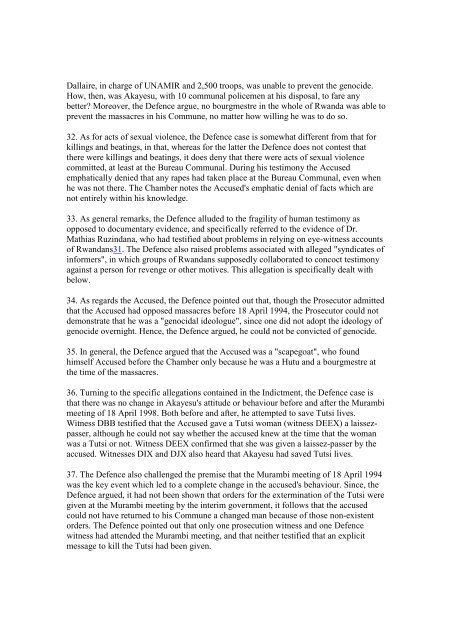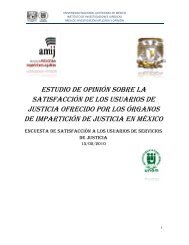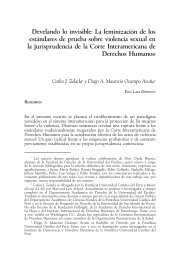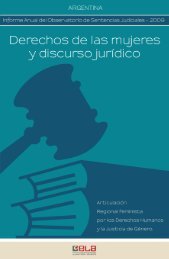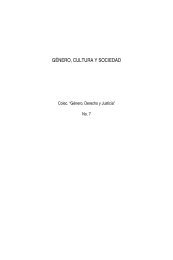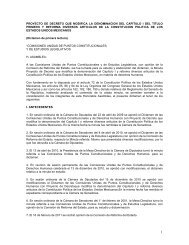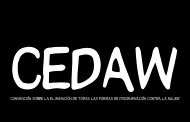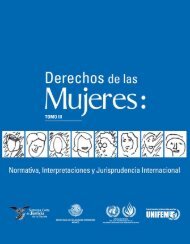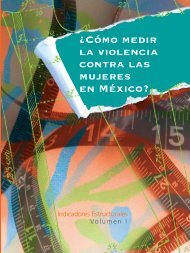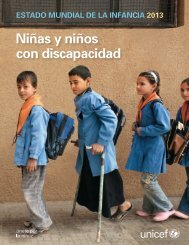Case No. ICTR-96-4-T - International Criminal Tribunal for Rwanda
Case No. ICTR-96-4-T - International Criminal Tribunal for Rwanda
Case No. ICTR-96-4-T - International Criminal Tribunal for Rwanda
- No tags were found...
Create successful ePaper yourself
Turn your PDF publications into a flip-book with our unique Google optimized e-Paper software.
Dallaire, in charge of UNAMIR and 2,500 troops, was unable to prevent the genocide.How, then, was Akayesu, with 10 communal policemen at his disposal, to fare anybetter? Moreover, the Defence argue, no bourgmestre in the whole of <strong>Rwanda</strong> was able toprevent the massacres in his Commune, no matter how willing he was to do so.32. As <strong>for</strong> acts of sexual violence, the Defence case is somewhat different from that <strong>for</strong>killings and beatings, in that, whereas <strong>for</strong> the latter the Defence does not contest thatthere were killings and beatings, it does deny that there were acts of sexual violencecommitted, at least at the Bureau Communal. During his testimony the Accusedemphatically denied that any rapes had taken place at the Bureau Communal, even whenhe was not there. The Chamber notes the Accused's emphatic denial of facts which arenot entirely within his knowledge.33. As general remarks, the Defence alluded to the fragility of human testimony asopposed to documentary evidence, and specifically referred to the evidence of Dr.Mathias Ruzindana, who had testified about problems in relying on eye-witness accountsof <strong>Rwanda</strong>ns31. The Defence also raised problems associated with alleged "syndicates ofin<strong>for</strong>mers", in which groups of <strong>Rwanda</strong>ns supposedly collaborated to concoct testimonyagainst a person <strong>for</strong> revenge or other motives. This allegation is specifically dealt withbelow.34. As regards the Accused, the Defence pointed out that, though the Prosecutor admittedthat the Accused had opposed massacres be<strong>for</strong>e 18 April 1994, the Prosecutor could notdemonstrate that he was a "genocidal ideologue", since one did not adopt the ideology ofgenocide overnight. Hence, the Defence argued, he could not be convicted of genocide.35. In general, the Defence argued that the Accused was a "scapegoat", who foundhimself Accused be<strong>for</strong>e the Chamber only because he was a Hutu and a bourgmestre atthe time of the massacres.36. Turning to the specific allegations contained in the Indictment, the Defence case isthat there was no change in Akayesu's attitude or behaviour be<strong>for</strong>e and after the Murambimeeting of 18 April 1998. Both be<strong>for</strong>e and after, he attempted to save Tutsi lives.Witness DBB testified that the Accused gave a Tutsi woman (witness DEEX) a laissezpasser,although he could not say whether the accused knew at the time that the womanwas a Tutsi or not. Witness DEEX confirmed that she was given a laissez-passer by theaccused. Witnesses DIX and DJX also heard that Akayesu had saved Tutsi lives.37. The Defence also challenged the premise that the Murambi meeting of 18 April 1994was the key event which led to a complete change in the accused's behaviour. Since, theDefence argued, it had not been shown that orders <strong>for</strong> the extermination of the Tutsi weregiven at the Murambi meeting by the interim government, it follows that the accusedcould not have returned to his Commune a changed man because of those non-existentorders. The Defence pointed out that only one prosecution witness and one Defencewitness had attended the Murambi meeting, and that neither testified that an explicitmessage to kill the Tutsi had been given.


